Life is a Mushroom Hunt
By Manny Salzman and Jason Salzman
Once you start looking for urban mushrooms, you’ll find them wherever you go, from the bike path to the wet carpet in your basement bathroom, bringing surprises and always-welcome happiness into your life.
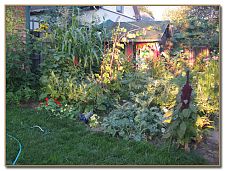
Once you catch urban myco-fever, you’ll see a garden like this and think about the mushrooms that might be growing under the flowers or veggies. 
Mycophobic mushroom myco-kicker at work. |
But like most things that provide happiness, urban mushroom hunting has negative side effects, because not everyone is a friend of the urban mushroom hunter.
Unfortunately, once you get off the couch and spend more time prowling the neighborhood, you’ll start to recognize enemies you never saw before.
First there’s most of the mycophobic urban population, which is most of the people you see out there. They conduct continuing warfare against mushrooms wherever they grow.
For example, there are the myco-kickers. While we think kicking a mushroom is like kicking a flower, the myco-kickers freely stomp them, leaving mangled mushroom remains tragically scattered in the grass or sidewalk. We’ve probably seen people just walk by while this annihilation occurs right in front of them. Can you imagine what would happen if people went around stomping flowers for no reason?
The general mycophobic population likes to use poison as well. They will even apply chemicals on the fairy ring mushroom, the delicious Marasmius oreades, in the mindless hope of creating a perfect grass-only lawn.

Urban populations conduct warfare against mushrooms. |
In response to requests by hostile citizens, parks and recreation departments sometimes spray lawns with fungicides. For example, when we first started collecting urban mushrooms, a massive fruiting of the meadow mushroom (Agaricus campestris) appeared in a neighborhood park. The white caps of this choice edible blanketed the grass, making the place look like something a myco-lover doesn’t expect to see in real life, especially down the street. But the Parks Department launched a premeditated attack and administered a fungicide spray. Since then, except for a few refugees hidden under the shrubs, not a single mushroom can be found in the grass.
|
A crop of urban mushrooms ruined by a lawn mower |
Another enemy of the city mushroom forager is the lawn mower. Frequently, a crop of young mushrooms, barely emerging from the grass, is wiped out by the blades of the mower. Even innocent little kids can perpetuate this evil.
(Less frequent grass cuttings would not only enhance mushroom growth but also decrease pollution and the need for irrigation.)
As an urban mushroom gatherer, you’ll also add builders and land developers to your enemies list. Be prepared to weep when the nearby vacant lot, your annual source of yummy button mushrooms (Agaricus species) is paved or built over.
For years, on spring weekend mornings, our whole family headed to our favorite vacant lot along Cherry Creek to pick button mushrooms. It was like church for us, in some respects. But then the developers moved in, paved our fungal paradise, and we were left with an empty bag, literally and figuratively. (Fortunately, we still pick wild asparagus along the river bank, which we believe is banned from development.)
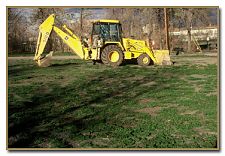
We picked many a mushroom at this vacant lot until the developers ruined it. |
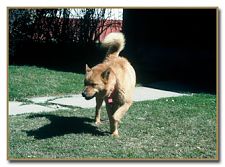
Once your best friends, dogs become enemies of urban mushroom hunters. 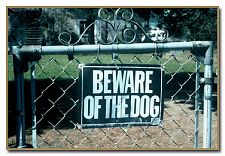
Is it worth the risk of a dog attack to collect a mushroom in this yard? 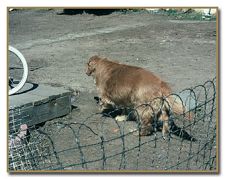
You can see that mushrooms can no longer grow in this yard, due to habitat destruction by dogs. |
You can work around lawn mowers and construction projects, but dogs present a serious challenge to the urban mushroom hunter on a number of levels.
There’s the yard containing a meaty shaggy parasol (Lepiota rachodes), but it’s got a snarling pitbull in it, precluding you from picking a choice edible. This happens more than you think, and trust us, once they become urban mushroom hunters, even the most dog-loving people start looking at canines differently.
And as you probably know, dogs tear up terrain worse than kids do. We used to collect puffballs in our neighbor’s backyard until she got a puppy, which was sweet enough, but permanently destroyed the puffball habitat.
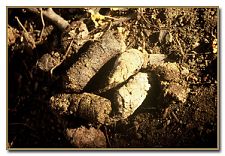
Dog poop is the bane of the urban mushroom hunter. |
Fortunately, there’s plenty of dog-free terrain out there, but worse than the dogs themselves is definitely their poop. Watch for it when you kneel down to pick a mushroom from the grass. And you might want to give your larger mushrooms a whiff to make sure Snoopy didn’t pee on them. Dogs confuse mushrooms with fire hydrants.
Mushroom Forays to and from Work
We first found urban mushrooms while riding our bicycles to and from work. Our discovery spawned an addiction. Soon we were conducting twice daily mushroom forays on workdays during the mushroom season. In our first year, we identified about a dozen species, including several delicious varieties, frequently enough for an appetizer before dinner.
Now we look for mushrooms while we walk the dog, eat lunch (or skip eating), push the shopping cart out of the market, cut the lawn, and stroll in the park with friends. There are mushrooms, including many good edibles, next to the jungle gym, on the 9th hole fairway, on the rotting shag rug in the basement, along grassy strips between sidewalks and curbs, on stumps and trees, under hard-packed soil—just about everywhere.
City mushroom hunting gives us the chance to talk to our neighbors about something besides the ugly yellow paint job on the house down the street or other regrettable gossip. Like us, through your urban mushroom forays, you may also finally get to know the people who live near you.
Asking permission to pick a mushroom from someone’s lawn can lead to bizarre and amusing conversations, usually beginning with quizzical silence. Once the fear fades, people usually become interested and have even become our friends, calling us every year when the mushrooms return. (This can get out of hand, though, as one neighbor phoned us dozens of times each summer for a number of years, until we had to explain that we had plenty of our own mushrooms to collect.)
Few of our neighbors, however, have taken us up on our suggestion to eat the mushrooms growing in their yards. They come up with lame excuses. For example, one woman complains that she’d really like to cook them, but her husband wouldn’t eat them. Another says she loves mushrooms and would eat the ones in her yard, but they’re so pretty she prefers to look at them. (Yet, she offers us as many as we want to take.) And one man says he already has too much food in the fridge.
What Are Urban Mushrooms?
The types of mushrooms that grow in forests can vary dramatically from one corner of our continent to the other. But visit virtually any lawn or garden in a North American city and you’ll likely be surprised to find a familiar set of fungi, which Scottish mycologist Roy Watling has dubbed “cosmopolitan species.” Or, as we call them, urban mushrooms.
This means that when you visit cities across America, from New York to San Francisco, and you poke around the yards, you’ll probably find some familiar fungal friends.
Mycologists have observed that this is not just a North American phenomenon, but a global one. You'll find a familiar set of urban areas in temperate climates around the world on lawns and, to some degree, in gardens. So, though you'll find different mushrooms in cities worldwide, you’ll find a core group of species in European towns that you find here in the U.S.
For example, after foraying in the snowy Martial Mountains at the southernmost tip of South America, Dr. Rolf Singer stepped out of the bus and onto the grass in Usuhaia, the capital of Tierra del Fuego. He looked down, saw a number of familiar mushrooms in the grass, and told noted mycologist Gary Lincoff: “Coprinus comatus. Like most mushrooms that favor urban sites, they may not be what you travel to the most remote corners of the world to find. They [urban mushrooms] are more like your neighbors that you travel abroad to escape for a while, but where they can live, you can live.” To which Gary replied, “People I know may covet what their neighbors possess, but they don’t eat them.”
Scope of Mushrooms on this Website
This website describes common mushrooms, both edible and poisonous, found in urban areas, mostly in lawns and gardens. It includes the mushrooms that you’d most likely see if you were to look for mushrooms on a random lawn in the temperate zone. Most of the species described grow on lawns, wood, or compost of various types. However, our research has revealed that a handful of mycorrhizal (my-coh-rise-ahl) mushrooms, which grow in association with trees, are common in some cities. So, we have included them on our list. (We’ve also included a couple rare species that are so deadly we could not, in good conscience, omit them.)
Unfortunately, you’ll have to consult other guides to identify some of the mushroom you’ll find on almost any urban foray. There are two reasons for this. First, this website focuses on the most common urban mushrooms. It does not describe all mushrooms that may turn up here or there in the lawns and gardens. Such a website would include many hundreds, if not thousands, of species: the odd Russula growing by the transplanted pine, the surprise Suillus in the park, the weird jelly fungus, and so on.
Second, this website—which, again, focuses mostly on mushrooms of lawns and gardens—omits many mushrooms that grow in urban forests or natural areas. In such places, you will probably find woodland or other wild mushrooms common in your region. In Central Park in New York City, for example, Gary Lincoff has found over 100 species. That’s because the Central Park is a natural habitat, with a diversity of trees and plants that support the growth of many mushroom types.
Still, you may be surprised that so many species—about 75 listed on this website—grow in the city. (About fifty of the most common are described.) The list reflects original field work by the authors as well as the suggestions of mushroom hunters from around the country. (If you find any that we’ve missed and should be included, please let us know on our comment board below.)
Depending on rainfall and your diligence as an urban forager, you should find about a dozen edible species during a summer of hunting. This will be enough not only to impress your frightened neighbors, but to enjoy several extraordinary meals of wild urban mushrooms.
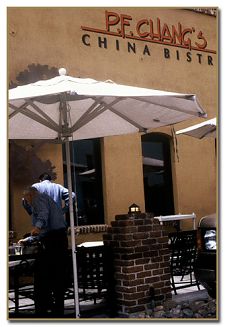
If you don’t find anything on your urban mushroom hunt, just go to a Chinese restaurant and order some. |
Eating Urban Mushrooms
We regularly eat mushrooms we from urban areas, despite the toxins that you find in all cities. But we take precautions. Typical herbicides applied to lawns don’t bother us, unless they've been applied within the previous few days, but we don’t eat mushrooms growing along old railroad beds, because mushrooms absorb heavy metals.
Unfortunately, there are no clear-cut rules about this. Some people are more cautious than others, as you can read on our website’s section on mushroom poisoning.
No Mushrooms in your Yard? No worries.
And if you find nothing? Not to worry. Just head to an Asian or gourmet market. Our website covers what you’ll find there, too. Rest assured, you’ll find some excellent specimens for your dinner table.
Or better yet, just head out to your favorite ethnic restaurant and order a dish with exotic mushrooms.
No walking, picking, identifying or cooking required at all. The wait staff will bring the mushrooms right to your table. Be as lazy as you want. It’s one of the many beautiful things about urban foraging.




